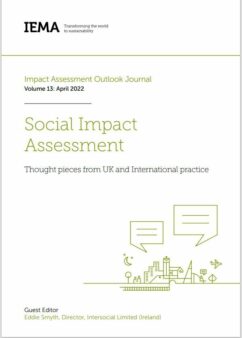Social impacts can be defined as any impact from an intervention (policy, plan, or project) that impacts people’s wellbeing, positively or negatively. Social impacts, according to the International Association of Impact Assessment (IAIA) guidance, include changes to people’s way of life, culture, political systems, environment, health, property rights, and fears and aspirations.
My professional career started out as an environmentalist focused on technical solutions, but I soon realised in working with farmers on environmental projects in the UK and Ireland that people needed to be central to any project for it to work. So, I retrained as a social development specialist and embarked on an international career in negotiating voluntary agreements with communities impacted by large projects in the infrastructure, renewables, extractives, and conservation sectors. In this edition, I have brought together papers that focus on the challenges of integrating SIA into impact assessment practice.
From practice, I have found that while developers and governments focus on highlighting the economic benefits of projects, communities are also concerned about the social and environmental impacts and this often leads to polarisation and conflict. The governance of projects involves a process for project approvals, which is meant to allow all parties to have an input in the decision-making process and SIA can be key in ensuring that people’s concerns are considered. Because I have developed a framework, the Sustainable Wellbeing Framework, to communicate the social, environmental, and economic factors that contribute to the wellbeing of people and the planet, I include it here to highlight the polarisation of sectoral interests on projects. It is common in impact assessment practice for project stakeholders to operate in silos and fail to understand the broad range of sustainability impacts that need to be considered on projects.
We have seen major opposition to many projects globally, including in the mining, fracking, and onshore wind industries, and dismissal of affected communities’ concerns as ‘Not-In-My-Backyard’ (NIMBY) reactions to resources used by society. In many cases, it is the very dismissal of community concerns that drives the divisions and opposition to projects as communities don’t feel respected or listened to. This in turn leads to a fear that if the local community is not considered, what else is amiss? The environmental philosopher Glenn Albrecht noted a consistent theme of distress caused by coal mining in Australia by the assault on the people’s sense of identity, place, belonging, control, and good health. He identified a melancholia from the loss of solace and comfort connected with their home which he termed ‘solastalgia’ – a form of homesickness that one gets when one is still at ‘home’ associated with the major project impacts they experienced. Social impacts can therefore range from significant health impacts to the loss of a cherished landscape and associated loss of a sense of place.
The first group of articles in this edition explores SIA practice in the UK and Ireland. The first article by Juliet Clark outlines the ongoing evolution of SIA practice in England. Liz Holford then outlines how GB rail is addressing the social pillar of sustainable development through the Rail Social Value Tool (RSVT). Robert Bain explores valuation methods for quantifying the socio-economic costs of litter in Scotland, which is important to incentivise firms and consumers to reduce the impacts of litter. Michelle De Waele examines the potential for cultural ecosystem services for Open Spaces as a trigger to sustainable waste and resource management in the Central Belt of Scotland. Nuala Carr outlines progress and challenges with SIA in Ireland, focusing on the onshore wind sector.
The second group of articles within this journal considers international SIA practice. Dr Richard Parsons presents the SIA guidelines in New South Wales in Australia, which has already proved influential in several decisions on mining projects. Asmita Kabra and Budhaditya Das assess lessons from eight years of SIA in India, which was introduced to address the negative impacts of land acquisition, rehabilitation, and resettlement. Finally, Ilse Aucamp outlines a practitioner’s perspective on developing SIAs in South Africa, including gaps in practice and new ways of looking at impacts.
If you are interested in being involved in the IA Network Social IA Working Group, IEMA members can email [email protected] to express an interest in joining the group.

Download a copy of the Outlook Journal here.
Please note: the views expressed in this blog are those of the individual contributing member and are not necessarily representative of the views of IEMA or any professional institutions with which IEMA is associated.
Subscribe
Subscribe to IEMA's newsletters to receive timely articles, expert opinions, event announcements, and much more, directly in your inbox.
Posted on 26th April 2022
Written by Eddie Smyth FIEMA
Latest Posts
-
IA Outlook Journal Volume 21: Impact Assessment Frontiers Part 2: People, Health and Equality
- 22nd July 2024 -
IEMA responds to Carbon Border Adjustment Mechanism (CBAM) consultation - July 2024
- 19th July 2024 -
The detail and policy action required beyond the King’s Speech
- 19th July 2024 -
Energy and Housing Bills included in the King’s Speech
- 17th July 2024 -
Launch of new resource for conservation technology tools
- 11th July 2024 -
Natural Capital 101: Guide for Sustainability Professionals
- 9th July 2024